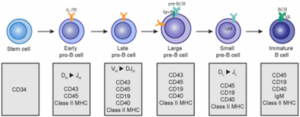8. Primary B-cell development
The primary B-cell development ends with a mature B-cell and takes place in the bone marrow and lymphoid tissues, while the secondary B-cell development takes place when the B-cell binds an antigen in a lymph node. Only 5% of the cells that begin primary B-cell development will finish it, the rest will die.
Development
B-cells develop from hematopoietic stem cells (HSCs) in the bone marrow. If the HSC expresses low levels of a protein called PU1, it will differentiate into a common lymphoid progenitor (CLP) cell. The CLP is bound to bone marrow stromal cells through adhesion molecules. It also expresses IL-7R, a receptor for interleukin-7, which is important in the development. Another important cytokine is B-cell activating factor (BAFF), which is important for the survival of B-cells in the periphery, before they are activated.

The primary development proceeds from stem cell to early pro-B cell to late pro-B cell to large pre-B cell to small pre-B cell to immature B cell. VDJ recombination for the heavy chain happens first and happens between the early pro-B to large pre-B stages. VDJ recombination for the light chain happens during the small pre-B cell stage.
During the large pre-B cell stage, the cell presents a pre-B-cell receptor on it’s surface, which is comprised of the heavy chain of the finished B-cell. If the cell cannot present the pre-B-cell receptor, it will be killed.
Selection of B cells
The B-cell undergoes two types of selection during its development. Positive selection occurs by checking whether the pre-B-cell receptor and mature BCR can transduce signals like normal. If they can’t they’re killed. Negative selection occurs by presenting self-antigens to the BCR. If it can bind strongly to it, it will be killed, or the BCR will be fixed. Negative selection ensures a state of central tolerance, where mature B cells don’t react to antigens found in the hosts body.
